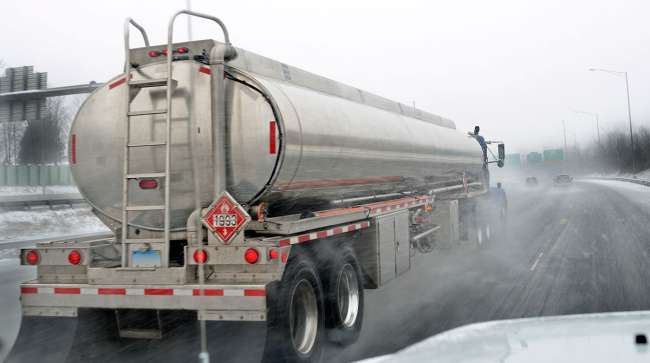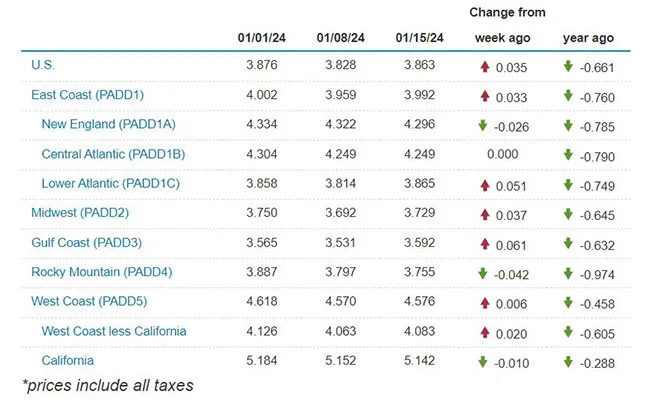Senior Reporter
Diesel Price Sees Its First Boost of the Year

[Stay on top of transportation news: Get TTNews in your inbox.]
The national average diesel price rose for the first time in 2024, climbing 3.5 cents to $3.863 a gallon, according to Energy Information Administration data for the week ending Jan. 15.
Diesel’s average price had fallen a combined 8.6 cents in the first two reporting periods of the year. Overall, the average price for a gallon has gone down 10 times in the past 12 weeks. A gallon of trucking’s main fuel now costs 66.1 cents less than it did at this time in 2023.
The average cost for a gallon of diesel went up in six of the 10 regions in EIA’s weekly survey, down in three and remained unchanged in the Central Atlantic. The biggest increase was 6.1 cents in the Gulf Coast; the biggest decline, 4.2 cents, came in the Rocky Mountain area.
Gasoline took a different route the past week, dipping 1.5 cents to an average of $3.058 a gallon. That represents a 25.2-cent decrease from this time a year ago.
U.S. On-Highway Diesel Fuel Prices

EIA.gov
The latest price figures come as EIA has issued its latest annual crude oil price forecast. The agency expects petroleum prices to remain “relatively balanced over the next two years” with Brent crude oil price averaging $82 per barrel this year and $79 in 2025, compared with its 2023 average of $82. EIA also said the benchmark oil, West Texas Intermediate, will be slightly lower but generally follow the same path.

Kloza
Oil Price Information Service founder Tom Kloza told Transport Topics that with home heating oil and diesel fuel being essentially the same product, demand is expected to increase. That is especially true in the Northeast and upper Midwest, where home heating oil still is used and with those sections of the country experiencing subzero temperatures and heavy snow.
“East Coast demand for heating purposes could push diesel futures prices up by 10 to 30 cents per gallon, and that would lift diesel prices through most of the country,” he said. “Beyond the molecules going to burn in the furnace, there are questions about refinery preparedness to deal with the disruptions that can come with brutal weather. Winter Storm Uri in 2021 knocked out about 2 million barrels per day of refining for weeks. Winter Storm Elliott in Christmas week 2022 also hamstrung refining, limiting inventory builds through January.”
#TodayInEnergy - EIA expects average U.S. gasoline and diesel prices to decrease in 2024 and 2025 #STEO https://t.co/ludEd1V90l pic.twitter.com/MBFpishXKo — EIA (@EIAgov) January 17, 2024
Much of the East, Midwest and parts of the Deep South have endured several days of extreme cold, with temperatures below zero. A large Arctic blast hit large swaths of the country, bringing heavy snowfall and blizzard conditions along with dangerous wind chills.
Kloza said the upper Midwest would seem prepared to deal with modest disruptions of home heating oil availability as inventories appear more than 15% above 2021 levels and almost equal to those of 2019. However, he expressed concern over the supply situation in the East Coast and parts of the mid-Atlantic, where inventories remain less than half of what is typical for this time of year. Kloza said parts of the region are “resource poor should mere normal weather come to pass.”
Shining Examples
In its new “Keep the Lights On” campaign, the American Petroleum Institute said the nation needs to follow three pillars for long-term energy success:
- Develop energy from diverse sources including oil and natural gas
- Continue to be aware of the critical role of energy for national security
- Continue to develop a modern infrastructure system to meet long-term energy demand while accelerating climate progress
Meanwhile, the Washington-based American Petroleum Institute unveiled a media campaign to encourage what it says is more energy exploration in the U.S. even as domestic fossil fuel production hit record levels in 2023 and is expected to increase this year.
API on Jan. 10 said that the increase in oil and natural gas production has stabilized world prices at a time when Russia is using profits from its energy production sector to fund its war against Ukraine, and other OPEC+ members are cutting oil production by hundreds of thousands of barrels per day because of overall lower energy demand worldwide.
“We produce more energy than any country in the world,” said Mike Sommers, CEO of API. “This benefits our economy, our national security and is our insurance in a volatile time. This is our American energy advantage. It didn’t happen overnight, and it can’t be sustained without the right policies from Washington.
“To maintain America’s energy advantage going forward, policymakers must increase energy leasing in federal lands and waters, approve permits in a timely manner and remove barriers to developing American energy.”
Want more news? Listen to today's daily briefing below or go here for more info:




